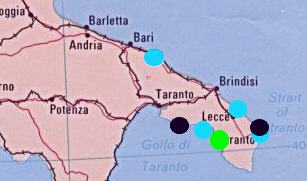

Crustacean mysids at present include more than 1000 species, widespread over all the continents, inhabiting coastal and open sea waters, as well as continental fresh waters, several taxa occuring also in different groundwater habitats and in anchialine caves.
Among the subterranean mysids, few species are stygophiles, rather than stygobiontes; in this case, adaptation to groundwater life is limited to reduction of eyes and/or body pigment; some marine species reported from coastal caves do not exhibit adaptation or specialization to the subterranean habitat.
True stygobitic groundwater mysids successfully colonized central America,
the Caribbean area and the Mediterranean basin; only three stygophilic species are known outside of these regions, viz. Spelaeomysis longipes and Spelaeomysis cochiensis from India, and Spelaeomysis servatus from Zanzibar and Kenya.
A tethyan origin is supposed for the most stygobitic mysids, with some reserve as regard the distribution patterns at specific level.
At present,17 stygobitic taxa, most endemic, are known from coastal caves, phreatic waters (wells) and anchialine habitats, the majority of which colonized the groundwater nets owing to stranding and uplifting of their marine ancestors pending the Pliocenic regressions of the Mediterranean.
Italian representatives of this order include only two stygobitic species, viz. Spelaomysis bottazzii Caroli 1924 (Lepidomysidae) and Stygiomysis hydruntina Caroli 1937 (Stygiomysidae) (only male described), both from karstic Salentine area in South Italy.
 |
The remarkable distribution of Stygiomysis undoubtedly points to a Tethyan origin, all the species of this genus being actually known from the Caribbean area and South Italy:
 S.hydruntina(South Italy)
S.hydruntina(South Italy) S.holthuisi(West Indian Islands)
S.holthuisi(West Indian Islands) S.major(Jamaica)
S.major(Jamaica) S.clarkei(Caicos Island and Providenciales Island)
S.clarkei(Caicos Island and Providenciales Island) S.aemete(Hispaniola)
S.aemete(Hispaniola)
 S. cokei (Mexico)
S. cokei (Mexico)
 S.sp.(South Italy)
S.sp.(South Italy) S.sp.(Mexico)
S.sp.(Mexico) S.sp.(Florida, U.S.A.)
S.sp.(Florida, U.S.A.)
On the contrary, the genus Spelaeomysis harbors eigth species, five of which (S. bottazzii, S. quinterensis, S. nuniezi, S. olivae, S. longipes) are endemic and of ancient origin; for the others (S. servatus, S. cardisomae, S. cochiensis) the hypothesis of a rather recent invasion of the ground waters could be suggested.
 S.bottazzii(South Italy)
S.bottazzii(South Italy)
 S.servatus(Kenya,Zanzibar,Aldabra)
S.servatus(Kenya,Zanzibar,Aldabra)
 S.quinterensis(Mexico)
S.quinterensis(Mexico)
 S.longipes(India)
S.longipes(India)
 S.nuniezi(Cuba)
S.nuniezi(Cuba)
 S.olivae(Mexico)
S.olivae(Mexico)
 S.cardisomae(Columbia,S.Andres)
S.cardisomae(Columbia,S.Andres)
 S. villalobosi (Mexico)
S. villalobosi (Mexico)
 S.cochinensis(India)
S.cochinensis(India)
Other mysids which occur in subterranean waters, including for the most part cave dwelling, stygophilic species, belong to the following genera: Antromysis, (Cuba, Mexico, Jamaica), Troglomysis (Yugoslavia s.l.), Heteromysoides (Canary Islands), Burrimysis (Balearic Islands), Leptomysis (France), Proleptomysis (Mediterranean), Anisomysis (Madagascar), Hemimysis (France), Bermudamysis (Bermuda), Aberomysis (Micronesia), Amathimysis (Caribbean), Mysidetes (Tasmania), Mysidium (Cuba), Palaumysis (Micronesia)
Other URLS with Mysids Information
 http://www.nfrcg.gov/nas/crustaceans/mrelicta.htm
http://www.nfrcg.gov/nas/crustaceans/mrelicta.htm
 World Groundwater Mysids
World Groundwater Mysids
 http://zoo.upe.ac.za/akad/Paul.htm
http://zoo.upe.ac.za/akad/Paul.htm
A selected World bibliography on subterranean mysids can be found in: Th. E. Bowman (1984). Mysidacea. Stygofauna Mundi: 405-409; Pesce G.L., Juberthie-Jupeau L. & Passelaigue F.(1994). Mysidacea. Encyclopaedia Biospeologica. Societ� de Biosp�ologie, Moulis, Bucarest: 113-119.
 Report comments and suggestions to [email protected]
Report comments and suggestions to [email protected]